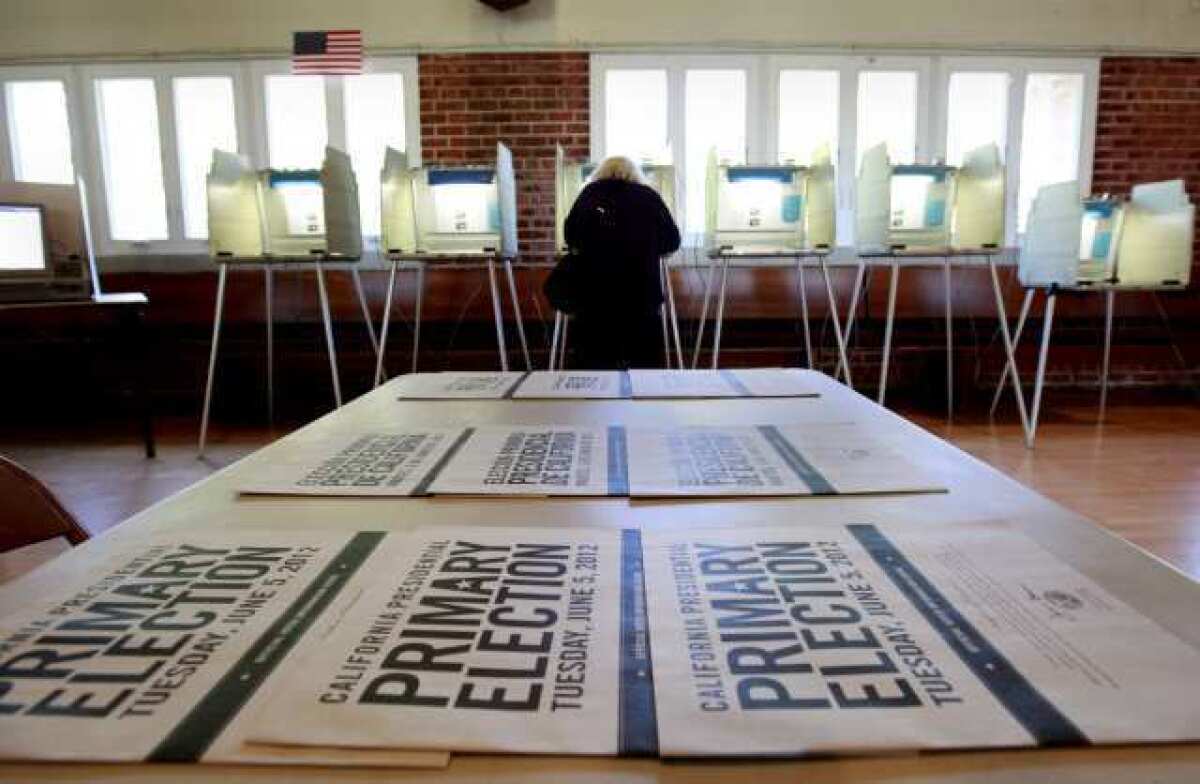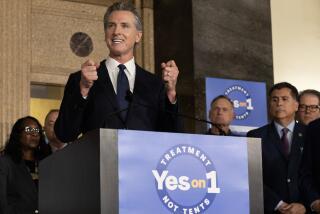Lessons for California in Tuesday’s vote

Ah, the smart money. It said Los Angeles City Atty. Carmen Trutanich might walk away with a win in the district attorney’s race Tuesday, even without a November runoff. Turns out the smart money was just big money and not all that smart after all. Trutanich is out of the race after voters picked Jackie Lacey and Alan Jackson for a Nov. 6 runoff. The city attorney’s immediate reaction was to blame negative media, demonstrating a bemusing lack of self-awareness. Might his poor showing have something to do with the things he did to earn that negative media? Such as running for district attorney after pledging not to and after slamming his rival three years ago for harboring exactly the same ambition?
Voters can be smarter than the smart money, and we like to think that was the case with Proposition 29, the tobacco tax initiative. If the current numbers hold, the measure will have been defeated by the slimmest of margins, perhaps because of the millions of dollars that tobacco companies poured into the campaign against it, or perhaps — just perhaps — because a majority of voters perceived that it would be foolish for the state to embark on a whole new taxpayer-funded cancer research enterprise. Tobacco in California remains undertaxed, and let’s hope that voters soon will have a chance to consider a smarter cigarette tax that would pay for medical care (including care made necessary by tobacco use) or meet any of the state’s other urgent needs.
It’s worth noting that California held its first top-two primary and the world kept turning. The new way of doing things — in which all candidates run in the primary and the top two go on to a runoff in November, regardless of party — divided races for Congress, the Assembly and the state Senate into four basic types. First there’s the dry run, in which there are only two candidates in the primary race, meaning it doesn’t really matter who comes in first and who comes in second. See, for example, the congressional race between Janice Hahn and Laura Richardson. Their November runoff will be a simple repeat, and it’s the same case with a handful of other races up and down the state. The situation may seem a little odd, but voters can handle it just fine.
Then there are the why-bother races, in which only one candidate runs in the primary (like Rep. Karen Bass, for example, and Assemblyman Isadore Hall), so, of course, there will be only one in the general election. Voters won’t have any more options than they would have under the old system, and that’s disappointing; but they won’t have any fewer either.
There are the old-school races, in which the primary produces a November face-off between one Republican and one Democrat, as in the Ventura County congressional race between conservative Tony Strickland and liberal Julia Brownley. The Times was hoping that independent candidate Linda Parks would be among the top two finishers there. But the fact that voters opted for the tried and true in no way undermines the promise of primary reform. Some observers were hoping the new system would produce more political centrist candidates and elect more to office, but that was never the most promising promise of top two. The idea is to elect candidates who must respond more to the desires of their constituents — all of them, not just those in their own party — and less to the dictates of party bosses. It may take several election cycles to see how well that’s working.
That brings us to the newfangled runoffs, like the one in the 50th Assembly District, in which two Democrats are running against each other. Formerly, a race like this one would now be virtually over because the Republican and third-party nominees wouldn’t have a ghost of a chance in November. But this time, the runoff — between Santa Monica Mayor Richard Bloom and Assemblywoman Betsy Butler — will give voters an actual decision to make. Critics say the race cuts out Republicans and other non-Democrats. Untrue. They may not like having to choose one of two Democrats, but their votes and their voices will be heard as each candidate tries to cobble together a coalition that will bring them victory. The same is true in races in which two Republicans will square off, such as Riverside County’s Assembly contest between Phil Paule and Melissa Melendez.
Won’t top two and independent redistricting deprive California of some of its most senior elected officials by making them run in competitive races that they might lose? Perhaps. In the Assembly and Senate, though, voters won back for themselves the option of sticking with a little seniority over new blood by convincingly approving Proposition 28. The term-limits tweak will allow a state lawmaker to ask voters to keep him or her in place, in the same house, for up to 12 years, instead of shuttling back and forth for up to 15 years.
Meanwhile — who is Elizabeth Emken? We’re about to find out. She did better than any of the other 22 candidates who were running against U.S. Sen. Dianne Feinstein and will be in the November runoff. Still, it’s worth noting that despite the number of people challenging her and what she claims was the loss of the bulk of her campaign treasury to fraud, Feinstein won nearly half the votes.
There will be no judicial runoffs in Los Angeles County; voters elected six Superior Court judges outright. Three incumbents handily beat back challenges from unqualified candidates who hoped to follow the example set six years ago by bagel shop owner Lynn D. Olson, who toppled a highly regarded veteran jurist. It’s more than a bit ironic that Olson is now one of those judges who had to fend off a challenge, but as unqualified as she may have been six years ago, she was a better candidate this time around than her opponent.
Don’t voters get some kind of break between Tuesday and campaigning for the Nov. 6 race? Of course they do; that’s what Wednesday was for. And maybe the first half of Thursday. Then it’s on to November.
More to Read
A cure for the common opinion
Get thought-provoking perspectives with our weekly newsletter.
You may occasionally receive promotional content from the Los Angeles Times.






